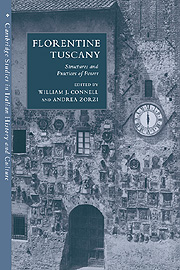Book contents
- Frontmatter
- Contents
- List of figures
- List of tables
- List of abbreviations of archival sources
- Introduction
- 1 The ‘material constitution’ of the Florentine dominion
- 2 The language of empire
- 3 Constitutional ambitions, legal realities and the Florentine state
- 4 Fiscality, politics and dominion in Florentine Tuscany at the end of the middle ages
- 5 Market structures
- 6 State-building, church reform and the politics of legitimacy in Florence, 1375–1460
- 7 The humanist citizen as provincial governor
- 8 Territorial offices and officeholders
- 9 Demography and the politics of fiscality
- 10 Florentines and the communities of the territorial state
- 11 Patronage and its role in government: the Florentine patriciate and Volterra
- 12 San Miniato al Tedesco: the evolution of the political class
- 13 The social classes of Colle Valdelsa and the formation of the dominion (fourteenth–sixteenth centuries)
- 14 Arezzo, the Medici and the Florentine regime
- 15 Rubrics and requests: statutory division and supra-communal clientage in Pistoia
- 16 A comment
- Index
- CAMBRIDGE STUDIES IN ITALIAN HISTORY AND CULTURE
11 - Patronage and its role in government: the Florentine patriciate and Volterra
Published online by Cambridge University Press: 16 September 2009
- Frontmatter
- Contents
- List of figures
- List of tables
- List of abbreviations of archival sources
- Introduction
- 1 The ‘material constitution’ of the Florentine dominion
- 2 The language of empire
- 3 Constitutional ambitions, legal realities and the Florentine state
- 4 Fiscality, politics and dominion in Florentine Tuscany at the end of the middle ages
- 5 Market structures
- 6 State-building, church reform and the politics of legitimacy in Florence, 1375–1460
- 7 The humanist citizen as provincial governor
- 8 Territorial offices and officeholders
- 9 Demography and the politics of fiscality
- 10 Florentines and the communities of the territorial state
- 11 Patronage and its role in government: the Florentine patriciate and Volterra
- 12 San Miniato al Tedesco: the evolution of the political class
- 13 The social classes of Colle Valdelsa and the formation of the dominion (fourteenth–sixteenth centuries)
- 14 Arezzo, the Medici and the Florentine regime
- 15 Rubrics and requests: statutory division and supra-communal clientage in Pistoia
- 16 A comment
- Index
- CAMBRIDGE STUDIES IN ITALIAN HISTORY AND CULTURE
Summary
Volterra represents a remarkable anomaly in the formation of the Florentine territorial state. It may be impossible to detect a general pattern in the incorporation of the communities into the large dominion emerging in fourteenth- and fifteenth-century Tuscany. However, the case of Volterra seems atypical for many reasons, the first of them being the late date of its formal submission to Florence (1472), which makes this town the only significant case of enlargement of the Florentine state in the Medicean period. On the other hand, this submission was only the final act of a long process begun in 1361.
And yet, precisely this atypicality, and in particular the persistence for over a century of a fundamental ambiguity in the relationships between ‘quasi-ruler’ and ‘quasi-subject’, makes it possible to distinguish with greater clarity some important elements relating to the general theme of this volume. I refer here, for example, to the divergence between juridical forms and political realities, to the complex relationship between institutional framework and practice of government, to the combination of regional policy with day-to-day local relations, and to the ubiquity of formal as well as informal negotiations.
Before discussing Volterra's case in broader terms, it may be opportune to outline the principal stages of its subjugation.
Florentine hegemony over Volterra, only intermittently established in the thirteenth century and in the first half of the fourteenth, was put on a solid and durable basis beginning in 1361.
- Type
- Chapter
- Information
- Florentine TuscanyStructures and Practices of Power, pp. 225 - 241Publisher: Cambridge University PressPrint publication year: 2000
- 1
- Cited by

